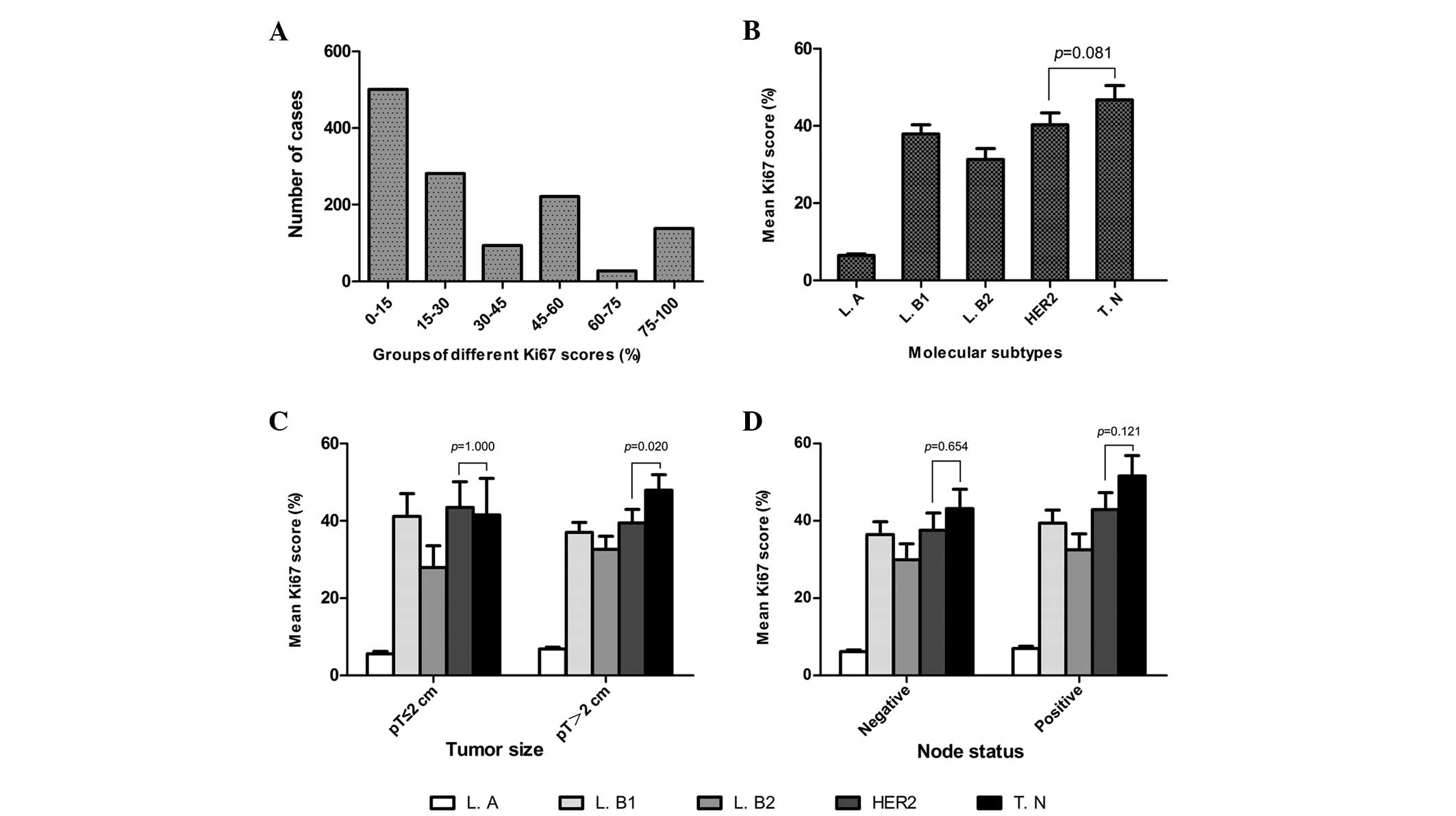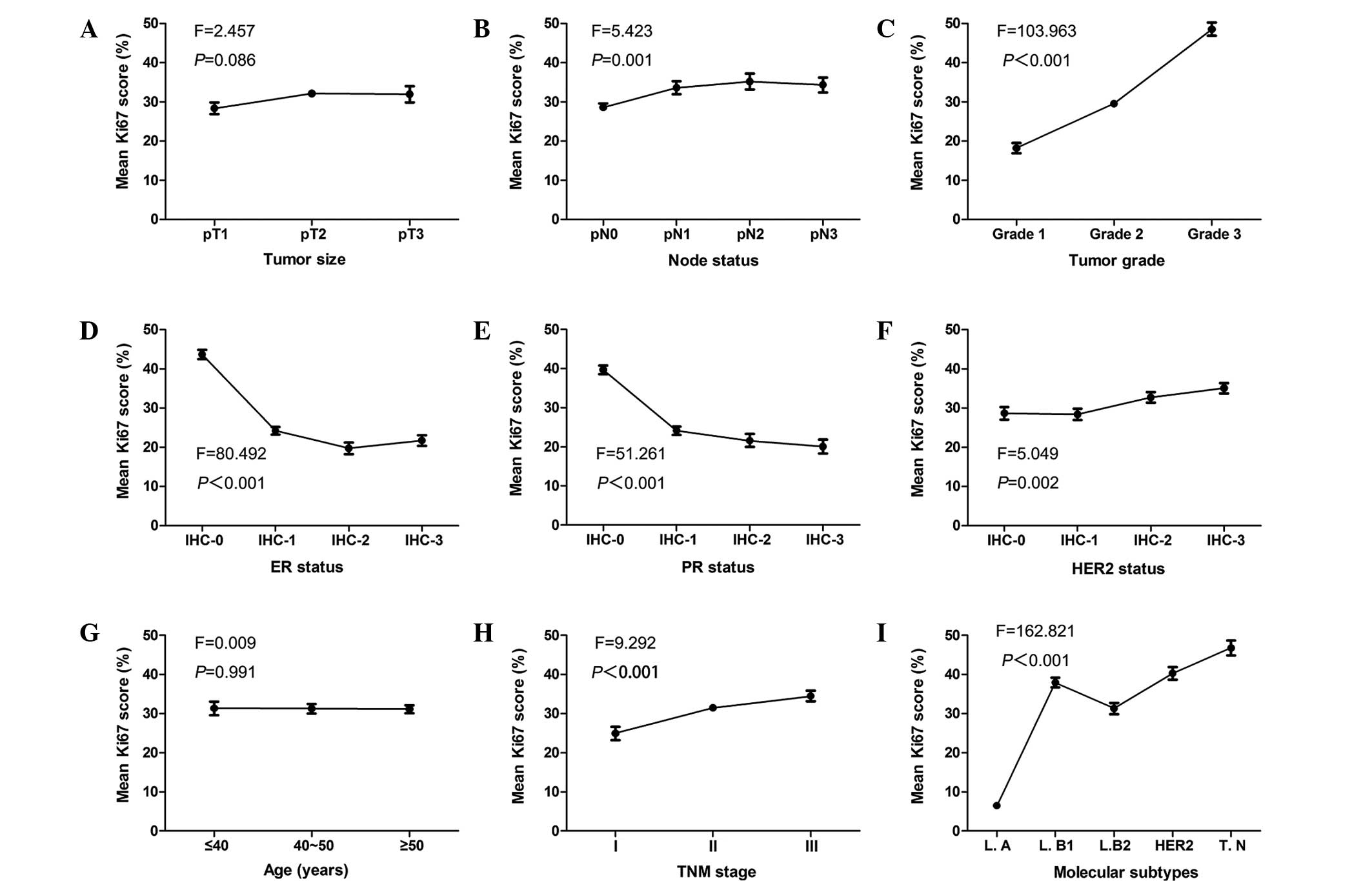|
1
|
Jemal A, Bray F, Center MM, Ferlay J, Ward
E and Forman D: Global cancer statistics. CA Cancer J Clin.
61:69–90. 2011. View Article : Google Scholar : PubMed/NCBI
|
|
2
|
Gerdes J, Schwab U, Lemke H and Stein H:
Production of a mouse monoclonal antibody reactive with a human
nuclear antigen associated with cell proliferation. Int J Cancer.
31:13–20. 1983. View Article : Google Scholar : PubMed/NCBI
|
|
3
|
Gerdes J, Lemke H, Baisch H, Wacker HH,
Schwab U and Stein H: Cell cycle analysis of a cell
proliferation-associated human nuclear antigen defined by the
monoclonal antibody Ki-67. J Immunol. 133:1710–1715.
1984.PubMed/NCBI
|
|
4
|
Gerdes J, Li L, Schlueter C, et al:
Immunobiochemical and molecular biologic characterization of the
cell proliferation-associated nuclear antigen that is defined by
monoclonal antibody Ki-67. Am J Pathol. 138:867–873.
1991.PubMed/NCBI
|
|
5
|
de Azambuja E, Cardoso F, de Castro G Jr,
et al: Ki-67 as prognostic marker in early breast cancer: a
meta-analysis of published studies involving 12,155 patients. Br J
Cancer. 96:1504–1513. 2007. View Article : Google Scholar : PubMed/NCBI
|
|
6
|
Kontzoglou K, Palla V, Karaolanis G, et
al: Correlation between Ki67 and breast cancer prognosis. Oncology.
84:219–225. 2013. View Article : Google Scholar : PubMed/NCBI
|
|
7
|
Jones RL, Salter J, A'Hern R, et al:
Relationship between oestrogen receptor status and proliferation in
predicting response and long-term outcome to neoadjuvant
chemotherapy for breast cancer. Breast Cancer Res Treat.
119:315–323. 2010. View Article : Google Scholar : PubMed/NCBI
|
|
8
|
Ellis MJ, Coop A, Singh B, et al:
Letrozole inhibits tumor proliferation more effectively than
tamoxifen independent of HER1/2 expression status. Cancer Res.
63:6523–6531. 2003.PubMed/NCBI
|
|
9
|
Dowsett M, Smith IE, Ebbs SR, et al IMPACT
Trialists: Short-term changes in Ki-67 during neoadjuvant treatment
of primary breast cancer with anastrozole or tamoxifen alone or
combined correlate with recurrence-free survival. Clin Cancer Res.
11:951s–958s. 2005.PubMed/NCBI
|
|
10
|
Dowsett M, Nielsen TO, A'Hern R, et al
International Ki-67 in Breast Cancer Working Group: Assessment of
Ki67 in breast cancer: recommendations from the International Ki67
in Breast Cancer Working Group. J Natl Cancer Inst. 103:1656–1664.
2011. View Article : Google Scholar : PubMed/NCBI
|
|
11
|
Cheang MC, Chia SK, Voduc D, et al: Ki67
index, HER2 status, and prognosis of patients with luminal B breast
cancer. J Natl Cancer Inst. 101:736–750. 2009. View Article : Google Scholar : PubMed/NCBI
|
|
12
|
Goldhirsch A, Wood WC, Coates AS, Gelber
RD, Thürlimann B and Senn HJ: Role: Panel MembersStrategies for
subtypes - dealing with the diversity of breast cancer: highlights
of the St. Gallen International Expert Consensus on the Primary
Therapy of Early Breast Cancer 2011. Ann Oncol. 22:1736–1747. 2011.
View Article : Google Scholar : PubMed/NCBI
|
|
13
|
Haroon S, Hashmi AA, Khurshid A, et al:
Ki67 index in breast cancer: correlation with other prognostic
markers and potential in pakistani patients. Asian Pac J Cancer
Prev. 14:4353–4358. 2013. View Article : Google Scholar : PubMed/NCBI
|
|
14
|
Pinder SE, Wencyk P, Sibbering DM, et al:
Assessment of the new proliferation marker MIB1 in breast carcinoma
using image analysis: associations with other prognostic factors
and survival. Br J Cancer. 71:146–149. 1995. View Article : Google Scholar : PubMed/NCBI
|
|
15
|
Midulla C, De Iorio P, Nagar C, et al:
Immunohistochemical expression of p53, nm23-HI, Ki67 and DNA
ploidy: correlation with lymph node status and other clinical
pathologic parameters in breast cancer. Anticancer Res.
19:4033–4037. 1999.PubMed/NCBI
|
|
16
|
No authors listed. The World Health
Organization. Histological typing of breast tumors. Neoplasma.
30:113–123. 1983.PubMed/NCBI
|
|
17
|
Robbins P, Pinder S, de Klerk N, et al:
Histological grading of breast carcinomas: a study of interobserver
agreement. Hum Pathol. 26:873–879. 1995. View Article : Google Scholar : PubMed/NCBI
|
|
18
|
Edge SB, Byrd DR, Compton CC, et al: AJCC
Cancer Staging Manual. 7th. Springer; New York, NY, USA: 2009
|
|
19
|
Hammond ME, Hayes DF, Dowsett M, et al:
American Society of Clinical Oncology/College Of American
Pathologists guideline recommendations for immunohistochemical
testing of estrogen and progesterone receptors in breast cancer. J
Clin Oncol. 28:2784–2795. 2010. View Article : Google Scholar : PubMed/NCBI
|
|
20
|
Wolff AC, Hammond ME, Hicks DG, et al
American Society of Clinical Oncology; College of American
Pathologists: Recommendations for human epidermal growth factor
receptor 2 testing in breast cancer: American Society of Clinical
Oncology/College of American Pathologists clinical practise
guideline update. J Clin Oncol. 31:3997–4013. 2013. View Article : Google Scholar : PubMed/NCBI
|
|
21
|
Fasching PA, Heusinger K, Haeberle L, et
al: Ki67, chemotherapy response, and prognosis in breast cancer
patients receiving neoadjuvant treatment. BMC Cancer. 11:4862011.
View Article : Google Scholar : PubMed/NCBI
|
|
22
|
Heusinger K, Jud SM, Haeberle L, et al:
Association of mammographic density with the proliferation marker
Ki-67 in a cohort of patients with invasive breast cancer. Breast
Cancer Res Treat. 135:885–892. 2012. View Article : Google Scholar : PubMed/NCBI
|
|
23
|
Ferguson NL, Bell J, Heidel R, et al:
Prognostic value of breast cancer subtypes, Ki-67 proliferation
index, age, and pathologic tumor characteristics on breast cancer
survival in Caucasian women. Breast J. 19:22–30. 2013. View Article : Google Scholar : PubMed/NCBI
|
|
24
|
Reyal F, Hajage D, Savignoni A, et al:
Long-term prognostic performance of Ki67 rate in early stage,
pT1-pT2, pN0, invasive breast carcinoma. PLoS One. 8:e559012013.
View Article : Google Scholar : PubMed/NCBI
|
|
25
|
Yerushalmi R, Woods R, Ravdin PM, Hayes MM
and Gelmon KA: Ki67 in breast cancer: prognostic and predictive
potential. Lancet Oncol. 11:174–183. 2010. View Article : Google Scholar : PubMed/NCBI
|
|
26
|
Kontzoglou K, Palla V, Karaolanis G, et
al: Correlation between Ki67 and breast cancer prognosis. Oncology.
84:219–225. 2013. View Article : Google Scholar : PubMed/NCBI
|
|
27
|
Mitrović O, Čokić V, Đikić D, et al:
Correlation between ER, PR, HER-2, Bcl-2, p53, proliferative and
apoptotic indexes with HER-2 gene amplification and TOP2A gene
amplification and deletion in four molecular subtypes of breast
cancer. Target Oncol. 9:367–379. 2014. View Article : Google Scholar : PubMed/NCBI
|
















